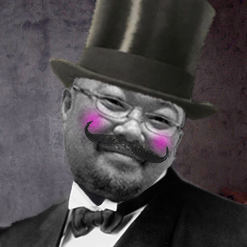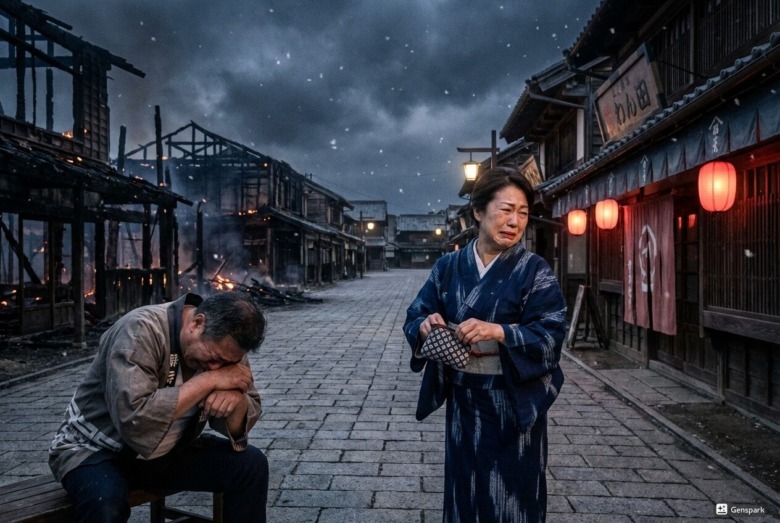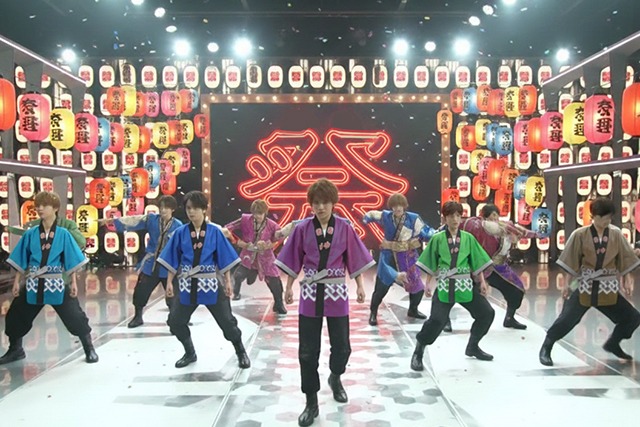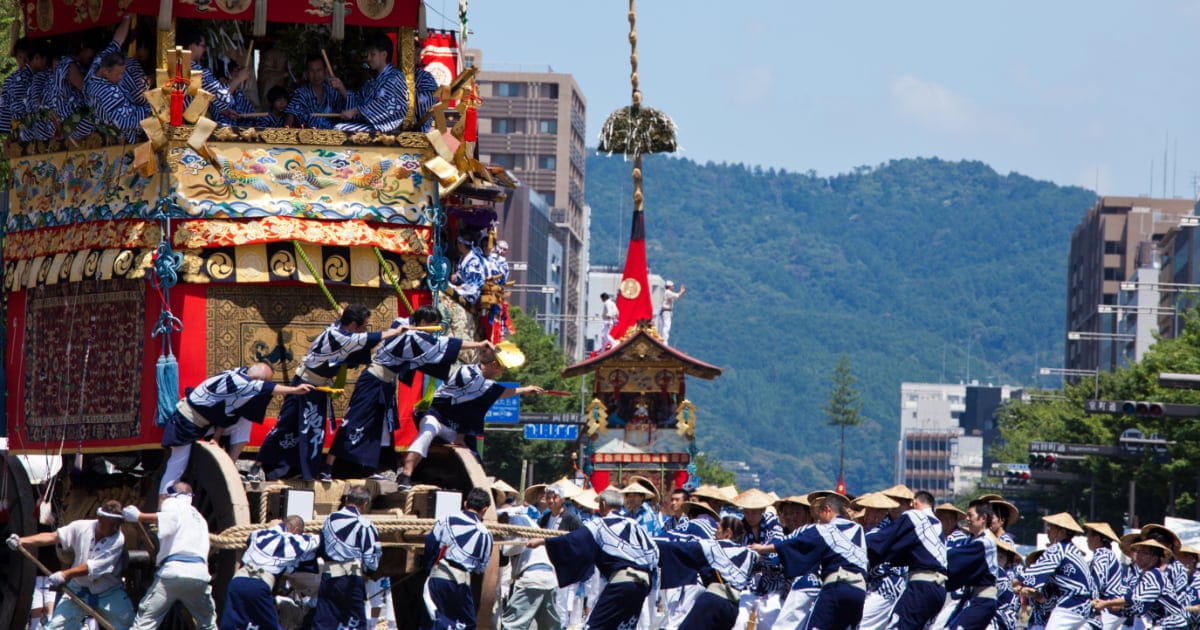Omatsuri mambo / Episode 3: After the Festival + Conclusion
Omatsuri sunde hi ga kurete
Tsumetai kaze no fuku yoru wa
Ie wo yakareta ojisan to
Hesokuri torareta obasan no
Hon ni setsunai tameiki bakari
Ikura naitemo kaeranai
Ikura naitemo ato no matsuri yoLyricist & Composer:HARA Rokurou
in 1952
After the festival is over and the day ends
On a cold, windy night
The friendly neighbor, the uncle who lost his house to fire
And the friendly neighbor, the auntie whose hidden savings were stolen
Let out truly heart-wrenching sighs
No matter how much they cry, it won’t come back
No matter how much they cry, it’s after the festival

Here the musical tone shifts dramatically. From the rhythmic, upbeat tempo, it changes to a slow tempo with a melancholic air, like a cold wind blowing. Like the stillness of a morning after the festival’s frenzy has departed. This modulation foreshadows the story’s conclusion.
The festival’s clamor departs, and silence returns to the streets. The lanterns’ light is extinguished, the stalls packed away, and a morning arrives that makes yesterday’s bustle seem like a lie. The uncle from Kanda and the aunt from Asakusa wake with a pleasant fatigue. Basking in the festival’s afterglow, just as they try to return to their everyday routines—

Ato no Matsuri – It is too late to call back yesterday
The uncle’s house has burned down without a trace. Someone’s shout of “Fire!” had been about his very home. The rubbing half-bell had rung urgently, and neighbors had desperately tried to inform him. But absorbed in carrying the mikoshi, the warning never reached the uncle’s ears. Only now does he understand the meaning of his neighbors’ frantic cries. But everything is too late. At the burned ruins, only a few charred pillars stand. His long-familiar home, his precious household belongings—all have turned to ash.
In the city of Edo, where wooden houses stood close together, arson was considered one of the gravest crimes. This was because a fire could consume not just one house but the entire neighborhood, sometimes even most of Edo. Therefore, the Edo shogunate established a special office called the “Hitsuke Touzoku Aratame-kata” (Arson and Robbery Control) to crack down on arsonists, bandit gangs, and other serious criminals. The Hitsuke Touzoku Aratame-kata was a special police-like entity separate from the regular town magistrate’s office. Leading subordinate doushin and yoriki, they investigated and arrested violent criminals. They were granted authority to torture suspects and, in some cases, to cut them down on the spot.

Fire Thief Inspector, HASEGAWA Heizo
A historical novel featuring HASEGAWA Heizou, a real person who served as head of this Hitsuke Touzoku Aratame-kata, is “Onihei Hankachou” (The Onihei Crime Files) by Shoutarou Ikeuchi. Though feared as “Oni no Heizou” (Demon Heizou), Hasegawa Heizou used former thieves as informants and maintained Edo’s security through compassionate investigation—his figure has captivated many readers. The novel was later adapted for television drama, and Kichiemon Nakamura’s portrayal of Onihei is deeply etched in period drama fans’ memories. Common people’s lives in Edo, the terror of fires, and the fight against crime—”Onihei Hankachou” is truly a masterpiece depicting both the light and shadow of the Edo period.

The aunt also faces a dire situation. Returning home, she finds that her cherished hidden savings have vanished completely. Having been too entranced by the kagura, she missed the warning that “a sneak thief is about—be careful!”
Here, let’s touch on the word “hesokuri” (hidden savings). Hesokuri refers to money saved bit by bit, secretly from one’s family. There are various theories about its etymology, but one says it comes from women in olden times who hid small coins earned from spinning hemp thread as a side job in the “heso” (the center part of the thread spool). The aunt’s hesokuri, accumulated painstakingly over many years—it must have been precious savings for enjoying her later years or for emergencies. All of it, lost in an instant.
“Ato no matsuri” (After the festival)—no Japanese idiom captures the two characters’ situation more precisely. This is an idiom meaning that just as it’s meaningless to go see the Gion Festival the day after it ends, once something is over, nothing can be done to retrieve the situation. This “ato no matsuri” is exactly what the uncle and aunt now face.

In rakugo, the punchline of a story is called the “sage.”
Here we find what rakugo (traditional comic storytelling) calls a “sage,” or punchline. Rakugo concludes stories with a sage. It might be a punchline that invites laughter, an ironic lesson, or sometimes something tinged with melancholy. This development in “Omatsuri Mambo” follows precisely the structure of a rakugo sage. The two characters, carried away by the festival and ignoring warnings, consequently suffer great losses. “See, I told you so”—what an ironic conclusion. Yet it contains a warm gaze toward downtown people and humor. This is truly “ato no matsuri”—a magnificent lyrical world.
This story, depicted in “Omatsuri Mambo,” is a masterpiece written and composed by HARA Rokurou. Hara drew inspiration from the idiom “ato no matsuri” to create this light, humorous yet profound story about life’s truths.
And the person who sang this song magnificently was MISORA Hibari, known as the “Songstress of the Showa Era.” MISORA Hibari, as a national singer representing postwar Japan, released numerous classic songs. Born in Yokohama in 1937, she debuted as a singer at age 9. Her exceptional vocal ability attracted attention early on, and she took the nation by storm as a “child prodigy singer.” Afterward, she continued producing timeless songs that resonated with people’s hearts: “Kanashii Sake” (Sad Sake), “Kawa no Nagare no You ni” (Like the Flow of a River), “Yawara” (Tenderness), “Ai Sansan” (Love Shining), “Midaregami” (Disheveled Hair), and many more.
MISORA Hibari’s greatness lies in her overwhelming expressive power. Not just enka, but jazz, blues, pop, folk songs—she mastered every genre and demonstrated peak expression in each. “Omatsuri Mambo” is another song where her diverse talents shine.

MISORA Hibari (1952), ”The Sankei Graphic”, Sankei Shinbun Co., Ltd. 1954., Public domain, By Link
MISORA Hibari’s voice beautifully contrasts the festival’s euphoria with the sobering reality that follows. The rhythmic, cheerful mambo beat of the first half suddenly shifts in the latter half to a melancholic slow tempo, conveying the harshness of reality. This exquisite expressive power elevates the song beyond mere comic entertainment to a masterpiece conveying life’s truths.
And interestingly, the song returns to its original tempo at the end. From the melancholic slow tempo back to the rhythmic upbeat tempo. It’s as if expressing the resilience of downtown people who shrug their shoulders saying, “Well, what can you do?” and resolve to live energetically from tomorrow. This is truly a festival-like ending. The festival passes through temporary clamor and returns to daily life. But those memories remain in people’s hearts, connecting to anticipation for the next festival.
“Omatsuri Mambo” depicts the very temperament of downtown people. Throwing themselves completely into immediate pleasures, not thinking about tomorrow. That innocence, that purity, sometimes leads to painful consequences. Yet even so, when the next festival comes, they’ll probably enjoy it the same way without learning their lesson. That bottomless cheerfulness, that resilience—that is the charm of Edokko and downtown people.

Daily Life in Edo. (by AI)
Happiness is fleeting. Festival clamor doesn’t continue forever; daily life inevitably returns. And sometimes, one must pay the price. But perhaps there’s meaning in life precisely in giving one’s all for those fleeting moments of happiness. “Omatsuri Mambo” gently depicts this essential truth about human nature, laced with humor.
HARA Rokurou’s skillful lyrics and composition, combined with MISORA Hibari’s expressively rich voice—these two elements fused magnificently to make “Omatsuri Mambo” a song for the ages. And notably, this song continues to be sung even now, more than half a century after its release. Performed at karaoke, played at festival venues, loved across generations—it’s being passed down not merely as an old nostalgic tune but as a living cultural heritage conveying the spirit of downtown culture continuing from the Edo period.

“Omatsuri mambo” is still sung today. (by AI)
We who live in modern times can learn much from this song. To enjoy present happiness with all our might. But simultaneously, not to become so intoxicated by that enjoyment that we lose sight of important things. That balance might be the wisdom for living life richly. “Omatsuri Mambo” conveys such profound life lessons on a light mambo rhythm. That’s why it continues to be loved by so many people even today.







コメント